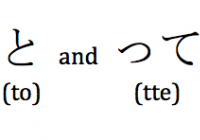Using the Japanese particles “to” (と) and “tte” (って) to quote [plus abbreviated uses and particle combinations]
The Japanese particle と (to) has a fairly large number of usages. In one of my dictionaries there are ten independent meanings listed. While I’d like to cover them all eventually, in this post I’m going to focus on one of the most common usages, that is when “to” is used to quote something. By “quote”,… Read More »



